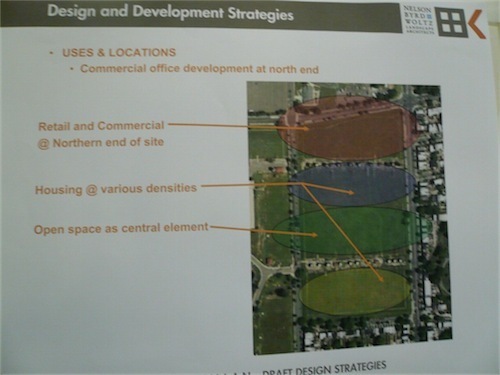The Unrepresented
There's a 25 acre chunk of land in DC located just south of a major hospital complex and otherwise surrounded by residential neighborhoods called the McMillan Sand Filtration Site. It's no longer needed for water-filtration purposes, so the idea is to redevelop it as someplace where people can live and work and shop. That requires a regulatory plan in which the interests of people who live in the McMillan-adjacent neighborhoods is being given heavy weight.
Lydia DePillis reports that one thing they want is low-density development, especially on the most promising retail corridor:
Based on the surrounding geography, master planner Matt Bell of EEK and landscape architect Warren Byrd of Nelson Byrd Woltz outlined a rough sketch of how the site's 25 acres might be apportioned: Office buildings would go on the north end, across Michigan Avenue from the medical center; townhouses would go on the south end, along Channing Street; with multifamily residential buildings and park space somewhere in between. They also proposed building higher towards the west side of the site, so as not to crowd the short townhouses on North Capitol Street, though that corridor was identified as the most viable location for retail (a representative from Councilmember Harry Thomas' office relayed North Capitol residents' strong desire not to have tall buildings across the street).
My very strong suspicion is that the North Capitol Street residents have a subjective understanding of their actions as jeopardizing the interests of rich developers. Harry Thomas, likewise, presumably sees himself as standing up for regular people against the rich developers. But what about the future residents of the McMillan site? Who's asking those people whether they'd prefer taller buildings and a richer retail environment? And who's asking the people who won't be able to move to the McMillan site in the future but who would have been able to move had higher-density construction been permitted?
Similarly, how about the ecological impact? It's not as if the people who don't move to McMillan will just vanish. Instead, they'll live someplace else—someplace with longer commutes—and the emissions from their automobiles will in a small way contribute to environmental problems around the world.
Of course this is just one largish patch of land in one American city. But just about every single infill planning process in America suffers from the exact same bias. The views and interests of people who currently live nearby are represented, but the views and interests of the future-people impacted by the process aren't. Consequently, each planning process is systematically biased toward permitting too-little development.


Matthew Yglesias's Blog
- Matthew Yglesias's profile
- 72 followers




